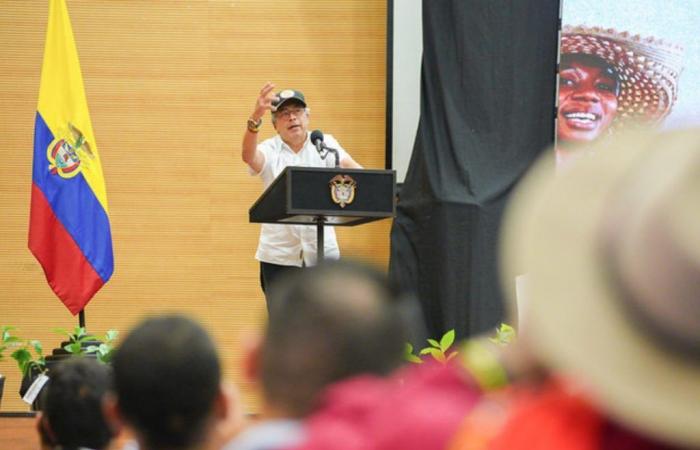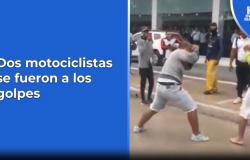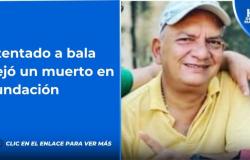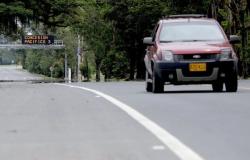“It seems that Cauca has always lived in war, but our challenge is how to get out of war and move on to peace?” said President Gustavo Petro last Friday in Cauca, before mayors, social leaders and communities of this region. department. His speech was within the framework of the presentation of Mission Cauca, a strategy that combines the action of public forces and the social investment of the government to confront the violence of the FARC dissidents and the expansion of illegal economies in Cauca. , and Jamundí, the municipality in the south of the Valley that borders Cali.
Mission Cauca is the version of the “total offensive” that Petro promised against the FARC dissidents with which the door to total peace has already been closed. Furthermore, this becomes the first version of a great military strategy of the left in power against a guerrilla, which not only involves the boot and the rifle.
Petro returns to a vision of security that seeks to attack the underlying problems with government investment, as other governments had tried. But it has at least two additional ingredients. On the one hand, a clear mandate to respect human rights symbolized by the Minister of Defense, Iván Velásquez, a lawyer who has done a task of purging the forces and opposes tactics such as bombings. On the other, the aspiration that communities in the midst of illicit economies support the government with which they have a political sympathy and that enters without the threat of forced eradication.
The military pincer
Since mid-March of this year, when President Petro ended the ceasefire with the structures of the Central General Staff (EMC) of the FARC in southwestern Colombia, a wave of violence has hit Cauca. Attacks with car bombs, drones with explosives, harassment and attempted armed takeovers in municipal capitals have been the response of the FARC dissidents in this department to the military offensives against them.
In this department alone there are more than 15 thousand members of the Military Forces, who are present and carry out daily operations against the FARC dissidents of the “Iván Mordisco” faction. A force that has been reinforced on several occasions since last March, in the face of attacks that have claimed the lives not only of members of the public force but also of civilians unrelated to the war.
The actions of an Army division with a specific command for this department and an air aviation battalion have been concentrated in Cauca. Also a marine brigade and a river battalion from the Navy, as well as an air combat command from the Air Force.
Strategic capabilities have also been deployed, such as a group of light armored vehicles, spike artillery, a fleet of helicopters including harpies and blackhawks, as well as a ghost plane. In addition, with the 16,000 plan of the Ministry of Defense, which seeks to train 16 thousand professional soldiers, it is expected to reinforce the strength of the ground operations battalions and military Gaulas.
However, the solitary action of the public force has not been enough to win the war against an armed group that is inferior in number and capabilities, but that has known how to slow down the military advance with antipersonnel mines, explosive drones, terrorist attacks and coercion to the communities.
The public forces know that they cannot win and transform a region as complex as Cauca alone. This is explained by General Eric Rodríguez, commander of the Southwest Joint Command, who presented to several journalists last Friday a detailed analysis of the public order situation in the department.
He says that the biggest challenge is not the 21 attacks with drones loaded with explosives that they have received this year, but the complex economic and coercive relationship that this armed group has woven with more than 40 thousand families that live off illicit crops in this department; which has more than 26 thousand hectares of coca, according to the latest UN monitoring report on coca crops in Colombia. “A hybrid treatment has to be given, because it is not only the military. “It is a social problem,” he said.
Rodríguez gave as an example the riot last Thursday, in Buenos Aires, Cauca. After an operation against a coca base paste processing laboratory, residents of this municipality removed the military and police. In addition, they burned two Police vehicles and an Army truck.
The public force has faced another 31 riots against the civilian population in Valle, Cauca and Nariño, during this year. “The real strength of the guerrilla is the relationship it has with our peasants. That is why today’s Cauca Mission seeks to change that relationship,” said General Rodríguez last Friday. For this reason, a battalion of the Comprehensive Action Army is also deployed in Cauca, soldiers without rifles in charge of more social tasks.
This vision of gaining the support of the population comes from classic military theories in irregular and counterinsurgency scenarios proposed since the last century. “The armed dimension is 25 percent of the matter and the other 75 percent is getting people to support us,” said British General Gerald Templer, a military leader who fought against the Malaysian guerrillas in the 1950s.
In Colombia, for example, this was the plan for the Comprehensive Consolidation of La Macarena during the Uribe government, which sought to remove the rearguard from the then Eastern Bloc of the FARC. With Duque, the Future Zones came later, a strategy that on paper also had the ambition of being a comprehensive intervention, but which ended up prioritizing forced eradication above all.
For Jorge Mantilla, an armed conflict researcher, the Cauca Mission faces the same challenges that these other initiatives faced. One of the main ones is to generate legitimacy for the public force in the midst of armed confrontations that have humanitarian impacts and anti-drug policies.
The previous government, of Iván Duque, lost that war. It was a government that maintained an aggressive campaign of forced eradication that threatened glyphosate, raised questions for hiding the deaths of minors in bombings, and launched operations that violated human rights, such as the one in Putumayo where 11 civilians died.
“Forced eradication in the past has produced problems of legitimacy, because it generated conflicts between communities that live off the coca economy and the State. Here, the substitution program to get out of illegality could be different,” Mantilla emphasizes, since this government’s commitment to stop eradicating small coca growers is clear.
And since his speech, Petro’s main bet to transform Cauca is to change illegal economies for legal economies, without the eradication that turned the Army into an occupying force foreign to the territory.
Furthermore, according to Minister Velásquez, “one of the important differences is that here they are not individual projects and actions of government entities. It is not the activity carried out on its own by the Ministry of Transportation and on the other by the Ministry of Health, but rather a true articulation of the government, which has been really very difficult.”
The pincer of social investment
At the launch of the strategy, Petro went to Cauca with a large group of officials. “We are going to win this war that the criminals have proposed to us based on a bet of State and peace,” said Alexander López, the director of the National Planning Department and articulator of this strategy, under the gaze of the president in Popayán.
López spent the last three weeks in meetings with mayors and social leaders of the department to make this plan, which Petro had ordered in a previous security council meeting at the end of May, a reality. In total, as a result of this coordination work, the government prioritized 117 initiatives for the seven subregions of the department, and promised an investment of 211 billion pesos.
In particular, according to Minister Velásquez, in the first phase, the investment will be concentrated in the municipalities of Cañón del Micay and in the north of the department, which is where military operations and dissident attacks have been concentrated.
One of the municipalities for which the most works were announced was Argelia and its El Plateado district, in the heart of the Micay Canyon and a military fort of the Carlos Patiño Front of the EMC. Minister Velásquez announced that the market square and a hospital will be built in El Plateado, a town of a little more than five thousand inhabitants that is in the corridor from the mountain range to the Pacific. They are also going to intervene on the highway from the capital of Argelia to El Plateado and improve 16 educational centers in this municipality.
The mayor of Algeria, Osman Guaca, welcomes this government initiative, as he knows first-hand the problem: more than 700 people have had to be forcibly displaced within the municipality due to the confrontations.
“For this we must make social investment. To the extent that we attack the fuel that fuels war on a daily basis, we will be successful. Otherwise we are going to continue this coming and going throughout the Micay region,” Guaca told La Silla. For example, they are also asking the government to invest in an agrotechnological transformation center to add value to the products that leave the region.
The State’s social investment is also key for Paola Castillo, mayor of Jamundí, the only municipality in the Valley that was included in Misión Cauca, since it has suffered 18 attacks by dissidents this year and is 10 minutes from Cali, where in four months COP16 will take place. “The articulated work between the community and the institutions is key so that we can not only occupy the territory, but also accompany the communities in their well-being,” she told La Silla.
In this way, the State opposes the strategy that the dissidents have had of gaining their social support by building roads and delivering works to the communities, largely during the six months of ceasefire. An example of this is the uncovered highway that goes from El Plateado to a navigable point on the Micay River that leads to the Pacific Ocean, and which was built with coca money and energized by dissidents.
Petro himself referred to this in his speech in Popayán. “The drug trafficker already made the road to the sea his way, they only pass the merchandise there, the ‘merca’ they call them. “Why don’t we build the road,” he said.
In his speech, Petro also mentioned a challenge that this program will face and that is bringing investment to regions where the conflict is alive and contractors can be extorted by illegal groups. The eternal paradox that the lack of State produces violence, but violence prevents the State from entering. For this reason, the president asked that works such as the highway from Algeria to El Plateado be carried out by the Army itself.
On the other hand, faced with the transformation of illegal economies, the government initially launched a program that seeks to benefit 5,000 families with coffee and bean seeds. This would also be for the Micay Canyon and northern Cauca. The government sent a signal of joint work with the private sector through the presence of businessman Tulio Gómez at the launch, who promised to buy all the production that comes out of this program. Gómez is the owner of América de Cali and they have retail businesses in the southwest.
Even if all this goes well, for researcher Mantilla there remains a great long-term challenge: sustainability. “It is very difficult for the government to be able to sustain these initiatives over time or to transfer, as it is supposed to be, those capacities to the local governments and the communities that are there. That challenge remains the same as in the past,” he says.






